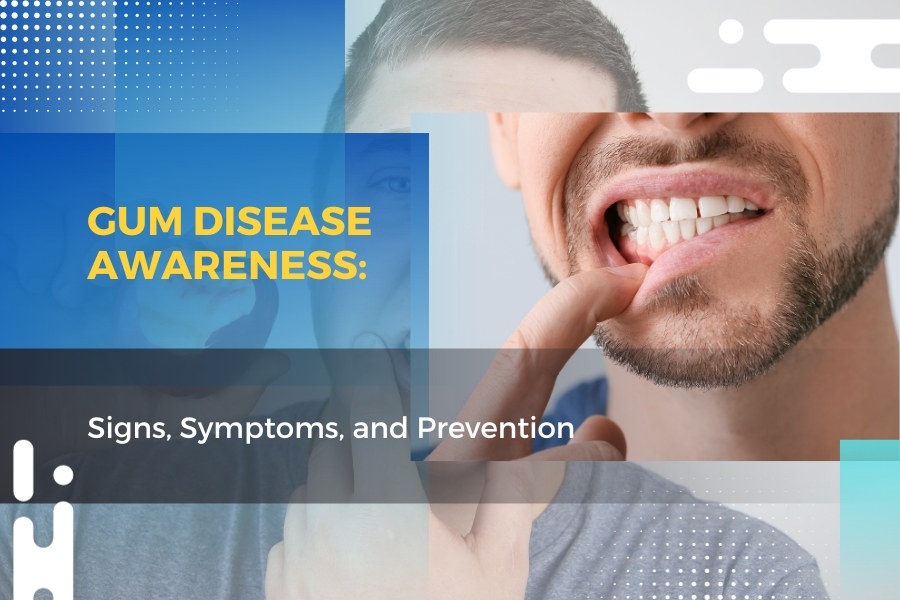
Gum Disease Awareness: Signs, Symptoms, and Prevention
Periodontal disease, another name for gum disease, is a common illness that affects the
tissues that hold your teeth in place. It is brought on by plaque accumulation on teeth and in
the gum line, which harbors bacteria that can lead to infection and inflammation. If left
untreated, gum disease can progress from moderate gingivitis to more severe periodontitis,
which can result in tooth loss. We'll talk about gum disease prevention, indicators, and
signals in this post.
Gum Disease Symptoms and Indications.
Symptoms of gum disease could include:
● Inflamed or red gums
● bleeding or sensitive gums
● Bad breath (halitosis)
● unpleasant chewing
● slack teeth
● Teeth sensitivity
● Pulling your gums away from your teeth
● Any modification to the way your teeth meet when you bite
● Any modification to the fit of your partial dentures
The tissues surrounding your teeth gradually deteriorate, and most people with gum
disease—especially in the early stages—don't feel any pain. Thus, it's critical to recognize
the warning indicators. Gum disease progresses in four stages:
Gingivitis
The initial stage of gum disease is called gingivitis. When you brush or floss, it may bleed
from red, swollen gums at first. There isn't any bone loss at this point. Gingivitis is therefore
completely curable with the right care.
Early periodontitis.
The bone supporting your teeth may begin to deteriorate at this point. Even though you
could lose some bone, you can still keep your teeth if you receive the right care.
Moderate periodontitis.
Your teeth may feel loose at this point, and there has been a greater loss of bone. If you
receive the right care, you can still save your teeth, albeit it might take more involved
surgeries.
Advanced Periodontitis
Your teeth might require to be extracted due to the extreme bone loss.
Keeping Gum Disease at Bay.
Keeping your mouth healthy requires preventing gum disease. The following advice can
help avoid gum disease:
● Daily brushing and flossing helps get rid of the bacteria that lead to gum disease.
● Cleaning your teeth after meals helps get rid of plaque and food particles that have
gotten between your teeth and gums. Remember to include your tongue as well,
since bacteria like to lurk there.
● To help eliminate leftover food particles that when you floss or brush missed and to
help minimise plaque, use mouthwash.
● Give up smoking. One of the main risk factors for gum disease is smoking.
● Consume a diet rich in nutrients and low in sugar for optimal health.
● Control your stress because it can impair immunity and make it more difficult for your
body to fend against illness.
● For examinations, see a dentist at least once a year, or more often if you have any of
the risk variables or warning symptoms listed above. If you have gum disease, a
dentist can detect it during a standard examination. They will examine your teeth for
plaque accumulation and inquire about your symptoms. They could suggest that you
see a periodontist (a specialist in gums) for additional assessment and care.
● Assess your risk. Your risk of developing periodontal disease can be raised by age,
smoking, nutrition, and genetics. Make sure to discuss your greater risk with your
dental practitioner.
Conclusion
If left untreated, gum disease is a common ailment that can result in tooth loss. It is brought
on by plaque accumulation on teeth and in the gum line, which harbours bacteria that can
lead to infection and inflammation. Gum disease symptoms can show up with red, swollen,
irritated, or bleeding gums; it can also cause poor breath, uncomfortable chewing, loose,
sensitive teeth, or gums that have peeled away from your teeth. Keeping your mouth healthy
requires preventing gum disease. Important measures to avoid gum disease include
brushing and flossing daily, using mouthwash, visiting the dentist frequently, stopping
smoking, maintaining a healthy diet, controlling stress, and being aware of your risk factors.